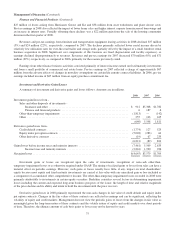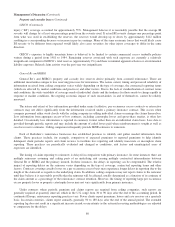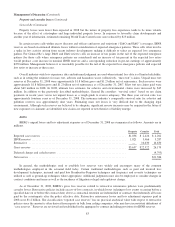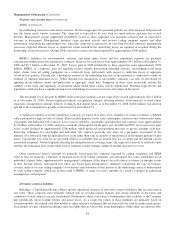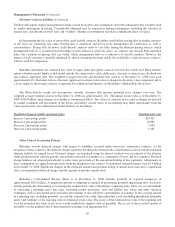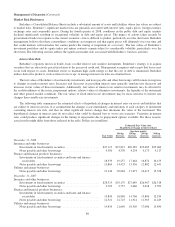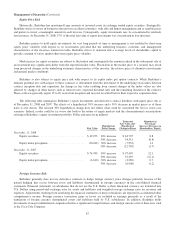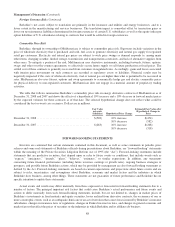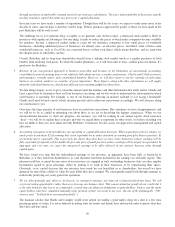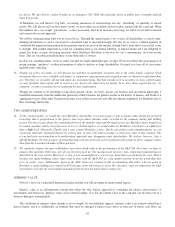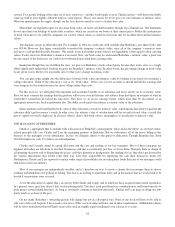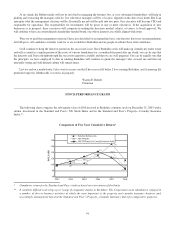Berkshire Hathaway 2008 Annual Report Download - page 87
Download and view the complete annual report
Please find page 87 of the 2008 Berkshire Hathaway annual report below. You can navigate through the pages in the report by either clicking on the pages listed below, or by using the keyword search tool below to find specific information within the annual report.
Management’s Discussion (Continued)
Derivative contract liabilities (Continued)
Unobservable inputs require management to make certain projections and assumptions about the information that would be used
by market participants in pricing. Considerable judgment may be required in making assumptions, including the selection of
interest rates, default and recovery rates and volatility. Changes in assumptions may have a significant effect on values.
In determining the fair value of most of the credit default contracts, Berkshire used bid/ask pricing data on similar contracts
as the basis for estimating fair value. Pricing data is monitored and reviewed by management for consistency as well as
reasonableness. Pricing data for newer credit default contracts tends to vary little among the different pricing sources, which
management believes is an indication that trading of such contracts is relatively active. As contracts age towards their expiration
dates, the variations in pricing data can widen, which management believes is indicative of inactive markets. However, the
impact of such variations is partially mitigated by shorter remaining durations and by the availability of data on newer contracts,
which is used for comparison.
Berkshire determines the estimated fair value of equity index put option contracts based on the widely used Black-Scholes
option valuation model. Inputs to that model include the current index value, strike price, discount or interest rate, dividend rate
and contract expiration date. The weighted averaged discount and dividend rates used as of December 31, 2008 were each
approximately 4%. Berkshire believes the most significant economic risks relate to changes in the index value component and to
a lesser degree to the foreign currency component. For additional information, see Berkshire’s Market Risk Disclosures.
The Black-Scholes model also incorporates volatility estimates that measure potential price changes over time. The
weighted average volatility used as of December 31, 2008 was approximately 22%. The impact on fair value as of December 31,
2008 ($10.0 billion) from changes in volatility is summarized below. The values of contracts in an actual exchange are affected
by market conditions and perceptions of the buyers and sellers. Actual values in an exchange may differ significantly from the
values produced by any mathematical model. Dollars are in millions.
Hypothetical change in volatility (percentage points) Hypothetical fair value
Increase 2 percentage points .............................................................. $10,451
Increase 4 percentage points .............................................................. 10,882
Decrease 2 percentage points .............................................................. 9,598
Decrease 4 percentage points .............................................................. 9,182
Other Critical Accounting Policies
Berkshire records deferred charges with respect to liabilities assumed under retroactive reinsurance contracts. At the
inception of these contracts, the deferred charges represent the difference between the consideration received and the estimated
ultimate liability for unpaid losses. Deferred charges are amortized using the interest method over an estimate of the ultimate
claim payment period with the periodic amortization reflected in earnings as a component of losses and loss expenses. Deferred
charge balances are adjusted periodically to reflect new projections of the amount and timing of loss payments. Adjustments to
these assumptions are applied retrospectively from the inception of the contract. Unamortized deferred charges were $3.9 billion
at December 31, 2008. Significant changes in the estimated amount and payment timing of unpaid losses may have a significant
effect on unamortized deferred charges and the amount of periodic amortization.
Berkshire’s Consolidated Balance Sheet as of December 31, 2008 includes goodwill of acquired businesses of
approximately $33.8 billion. A significant amount of judgment is required in performing goodwill impairment tests. Such tests
include periodically determining or reviewing the estimated fair value of Berkshire’s reporting units. There are several methods
of estimating a reporting unit’s fair value, including market quotations, asset and liability fair values and other valuation
techniques, such as discounted projected future net earnings or net cash flows and multiples of earnings. If the carrying amount
of a reporting unit, including goodwill, exceeds the estimated fair value, then individual assets (including identifiable intangible
assets) and liabilities of the reporting unit are estimated at fair value. The excess of the estimated fair value of the reporting unit
over the estimated fair value of net assets would establish the implied value of goodwill. The excess of the recorded amount of
goodwill over the implied value is then charged to earnings as an impairment loss.
85


